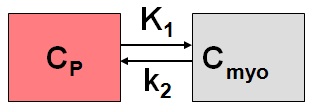The Card. NH3(De Grado) model has been developed by DeGrado et al. [1] for cardiac PET studies using 13NH3 ammonia bolus injection. It is based on a 1-tissue compartment model with plasma activity CP(t) and total uptake in myocardium Cmyo(t).

Operational Model Curve
The plasma activity is calculated from the total activity in the left ventricular cavity Clv(t) by a linear metabolite correction with factor mCorr
![]()
A value of mCorr=0.077 [1/min] has been found in humans [1]. The resulting differential equation for myocardial uptake is
![]()
where K1 equals myocardial blood flow F. The model curve incorporates a cardiac dual spillover correction, resulting in the operational equation
![]()
where
VLV = spill-over fraction of the blood activity in the left ventricle CLV(t),
VRV = spill-over fraction of the blood activity in the right ventricle CRV(t) .
DeGrado et al. recommend to only use the first 4 minutes of data after injection of the tracer to reduce the effects of metabolite buildup and washout.
Implementation
When using the model from the PCARD module, the data are transferred appropriately. When using it in PKIN the blood data have to be loaded as follows:
The following automatic adjustments are performed within the model:
Parameter Fitting
The model includes the 4 fitable parameters F, vRV, vLV and k2. Please inspect the %SE standard error to get information about the reliability of the parameter estimates.
Reference
1. DeGrado TR, Hanson MW, Turkington TG, Delong DM, Brezinski DA, Vallee JP, Hedlund LW, Zhang J, Cobb F, Sullivan MJ et al: Estimation of myocardial blood flow for longitudinal studies with 13N-labeled ammonia and positron emission tomography. J Nucl Cardiol 1996, 3(6 Pt 1):494-507.